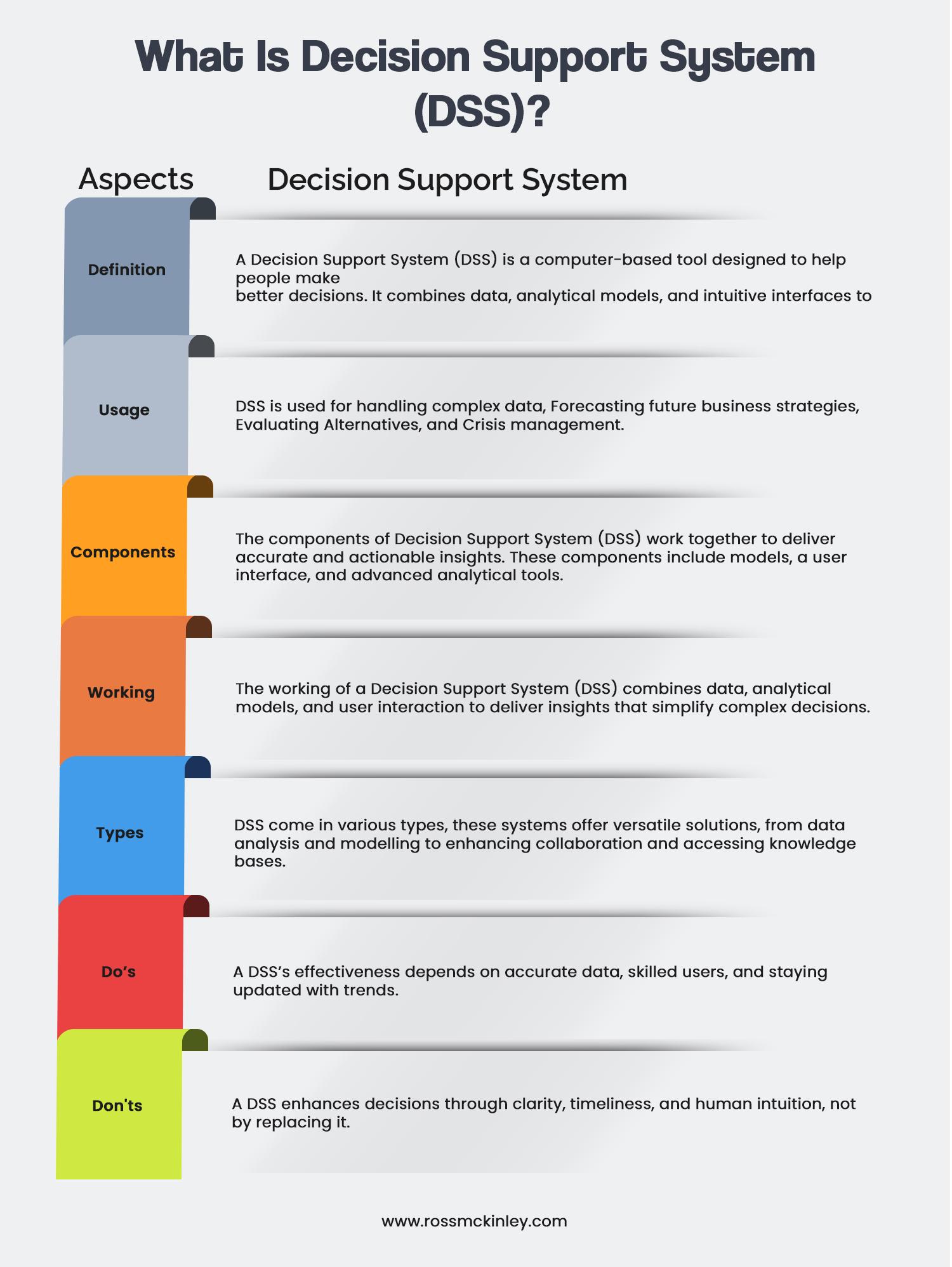
VAT On Imports
December 4, 2024
What Is a Suspense Account
December 5, 2024What Is A Decision Support System (DSS)?

Ever been stuck making a tough decision, like choosing between pizza toppings or which Netflix series to binge next? Now imagine facing a business decision involving millions of dollars. Scary, right?
That’s where a Decision Support System (DSS) comes to the rescue. A DSS is like a wise friend who gives you the best advice, but with the power of technology and data. Let’s dive into the world of DSS and see why businesses swear by it.

Table of Contents
Understanding Decision Support System
At its core, a Decision Support System (DSS) is a computer-based tool designed to help people make better decisions. It combines data, analytical models, and intuitive interfaces to support decision-making processes. Think of it as your digital crystal ball, showing you possible outcomes based on the data you feed it.
But don’t be fooled—DSS isn’t about replacing human decision-making; it’s about enhancing it. You still hold the reins, but with the Decision Support System, you have powerful insights to back you up.
Why Use a DSS?
Why bother with a DSS when you’ve got spreadsheets and coffee-fueled brainstorming sessions? Well, the answer’s simple. A Decision Support System (DSS) makes your decisions more innovative, faster, and more data-driven. Here’s when it’s beneficial:
1. Handling Complex Data
Businesses often deal with mountains of data, including sales figures, market trends, and customer feedback. A DSS sifts through the chaos and extracts the nuggets of gold.
2. Forecasting the Future
Do you need to predict sales for the next quarter or the impact of a new product launch? DSS uses models to simulate outcomes, helping you make informed bets.
3. Evaluating Alternatives
Can’t decide between numerous options? Here’s where a DSS saves the day. It lets you analyse the pros and cons of each choice, saving you from potential regret.
4. Crisis Management
In moments of uncertainty, which can be like a sudden supply chain issue, a DSS provides data-backed solutions to act swiftly and wisely.
Components of a Decision Support System
The power of a Decision Support System (DSS) lies in its key components, working together to deliver accurate and actionable insights. These components include models, a user interface, and advanced analytical tools, each playing a vital role in decision-making.
1. Model Management System
The model management system Stores models that managers can use in their decision-making. The models are used to determine the organisation’s financial health and forecast demand for a good or service.
2. User Interface
The user interface includes tools that help the end-user of a DSS to navigate through the system.
3. Knowledge Base
The knowledge base includes information from internal sources and external sources. Such as information collected in a transaction process system, newspapers, and online databases.
Working Of A Decision Support System:
The working of a Decision Support System (DSS) is like peeling back the layers of a well-oiled machine. It combines data, analytical models, and user interaction to deliver insights that simplify complex decisions.
A DSS ensures that you have all the tools to make smarter choices by collecting and processing data, running simulations, and presenting results in an easy-to-understand format.
1. Data Collection
The DSS pulls data from internal databases (like sales records) and external sources (like market reports). It’s like gathering puzzle pieces before assembling them.
2. Processing and Analysis
The DSS processes the data using advanced algorithms and models to uncover patterns, trends, and correlations. It’s the “aha!” moment for your data.
3. Presentation
The insights are presented in a user-friendly format, mostly dashboards, graphs, or reports, so that even non-tech-savvy users can make sense of them.
4. User Interaction
A Decision Support System is interactive. You can tweak parameters, run “what-if” scenarios, or explore specific insights to make tailored decisions.
Types of DSS
Decision Support Systems (DSS) come in various types, each tailored to specific decision-making needs. These systems offer versatile solutions, from data analysis and modelling to enhancing collaboration and accessing knowledge bases.
1. Data-Driven :
Uses internal or external databases and data mining techniques to identify trends and patterns and predict future events. They are commonly used in business decisions related to inventory, sales, and public sector applications like predicting criminal behaviour.
2. Model-Driven:
Relies on predefined decision models to analyse scenarios and meet specific user requirements. Examples include scheduling and financial statement development.
3. Communication-Driven:
Focuses on collaboration using tools like email, instant messaging, or voice chat to enable teamwork on shared tasks. It aims to improve collaboration, efficiency, and effectiveness.
4. Knowledge-Driven:
Powered by a continuously updated knowledge base maintained by a knowledge management system, it provides users with information aligned to a company’s processes and knowledge.
5. Document-Driven:
An information management system that retrieves and searches documents such as policies, procedures, meeting minutes, and corporate records to provide relevant data.
Do’s and Don’ts of Using a DSS
A retailer got overly excited with their DSS’s holiday season predictions and overstocked on novelty sweaters. Turns out, no one wanted neon green reindeer patterns. The takeaway? Use DSS responsibly! Using a DSS responsibly is like handling a sharp tool, it’s powerful but requires care.
DO:
– Garbage in, garbage out! Use accurate and relevant data.
– A DSS is only as good as the people using it. Invest in training.
– Keep your system aligned with current trends and data.
DON’T:
– It’s a guide, not an oracle. Combine its insights with human intuition.
– A DSS should simplify decisions, not confuse users.
– Time-sensitive decisions need quick actions, so act on insights promptly.
Conclusion
A Decision Support System (DSS) is like the superhero of the business world, swooping in with data-driven solutions when decision-making gets tough. Whether it’s analysing trends, simulating outcomes, or comparing alternatives, a DSS makes life easier and decisions smarter.
So, the next time you’re staring at a tough business decision, remember DSS is here to help. All you need to do is embrace the power of data, trust the process, and maybe avoid those neon green sweaters.
